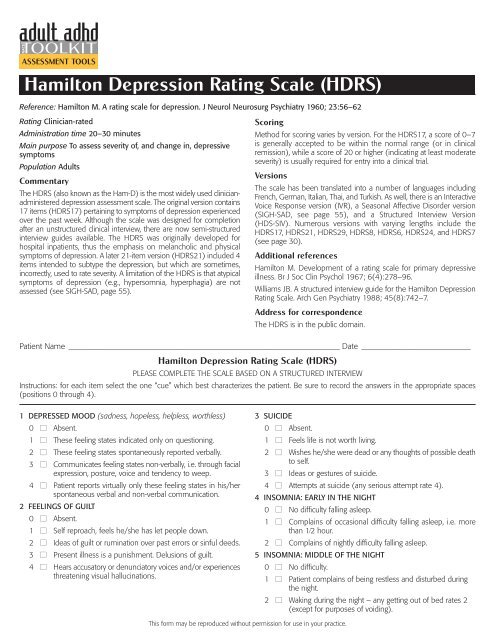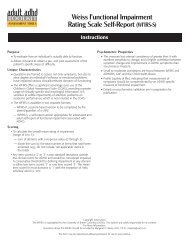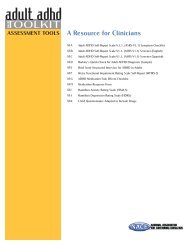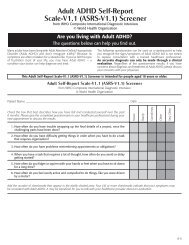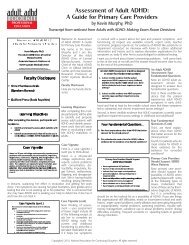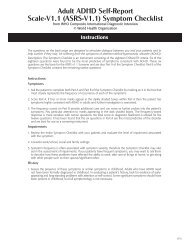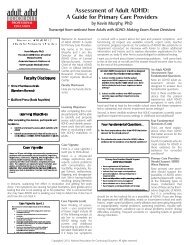Hamilton Depression Rating Scale (HDRS) ASSESSMENT TOOLS
Hamilton Depression Rating Scale (HDRS) ASSESSMENT TOOLS
Hamilton Depression Rating Scale (HDRS) ASSESSMENT TOOLS
Create successful ePaper yourself
Turn your PDF publications into a flip-book with our unique Google optimized e-Paper software.
<strong>ASSESSMENT</strong> <strong>TOOLS</strong><strong>Hamilton</strong> <strong>Depression</strong> <strong>Rating</strong> <strong>Scale</strong> (<strong>HDRS</strong>)Reference: <strong>Hamilton</strong> M. A rating scale for depression. J Neurol Neurosurg Psychiatry 1960; 23:56–62<strong>Rating</strong> Clinician-ratedAdministration time 20–30 minutesMain purpose To assess severity of, and change in, depressivesymptomsPopulation AdultsCommentaryThe <strong>HDRS</strong> (also known as the Ham-D) is the most widely used clinicianadministereddepression assessment scale. The original version contains17 items (<strong>HDRS</strong>17) pertaining to symptoms of depression experiencedover the past week. Although the scale was designed for completionafter an unstructured clinical interview, there are now semi-structuredinterview guides available. The <strong>HDRS</strong> was originally developed forhospital inpatients, thus the emphasis on melancholic and physicalsymptoms of depression. A later 21-item version (<strong>HDRS</strong>21) included 4items intended to subtype the depression, but which are sometimes,incorrectly, used to rate severity. A limitation of the <strong>HDRS</strong> is that atypicalsymptoms of depression (e.g., hypersomnia, hyperphagia) are notassessed (see SIGH-SAD, page 55).ScoringMethod for scoring varies by version. For the <strong>HDRS</strong>17, a score of 0–7is generally accepted to be within the normal range (or in clinicalremission), while a score of 20 or higher (indicating at least moderateseverity) is usually required for entry into a clinical trial.VersionsThe scale has been translated into a number of languages includingFrench, German, Italian, Thai, and Turkish. As well, there is an InteractiveVoice Response version (IVR), a Seasonal Affective Disorder version(SIGH-SAD, see page 55), and a Structured Interview Version(HDS-SIV). Numerous versions with varying lengths include the<strong>HDRS</strong>17, <strong>HDRS</strong>21, <strong>HDRS</strong>29, <strong>HDRS</strong>8, <strong>HDRS</strong>6, <strong>HDRS</strong>24, and <strong>HDRS</strong>7(see page 30).Additional references<strong>Hamilton</strong> M. Development of a rating scale for primary depressiveillness. Br J Soc Clin Psychol 1967; 6(4):278–96.Williams JB. A structured interview guide for the <strong>Hamilton</strong> <strong>Depression</strong><strong>Rating</strong> <strong>Scale</strong>. Arch Gen Psychiatry 1988; 45(8):742–7.Address for correspondenceThe <strong>HDRS</strong> is in the public domain.Patient Name ___________________________________________________________________ Date ___________________________<strong>Hamilton</strong> <strong>Depression</strong> <strong>Rating</strong> <strong>Scale</strong> (<strong>HDRS</strong>)PLEASE COMPLETE THE SCALE BASED ON A STRUCTURED INTERVIEWInstructions: for each item select the one “cue” which best characterizes the patient. Be sure to record the answers in the appropriate spaces(positions 0 through 4).1 DEPRESSED MOOD (sadness, hopeless, helpless, worthless)0 ■ Absent.1 ■ These feeling states indicated only on questioning.2 ■ These feeling states spontaneously reported verbally.3 ■ Communicates feeling states non-verbally, i.e. through facialexpression, posture, voice and tendency to weep.4 ■ Patient reports virtually only these feeling states in his/herspontaneous verbal and non-verbal communication.2 FEELINGS OF GUILT0 ■ Absent.1 ■ Self reproach, feels he/she has let people down.2 ■ Ideas of guilt or rumination over past errors or sinful deeds.3 ■ Present illness is a punishment. Delusions of guilt.4 ■ Hears accusatory or denunciatory voices and/or experiencesthreatening visual hallucinations.3 SUICIDE0 ■ Absent.1 ■ Feels life is not worth living.2 ■ Wishes he/she were dead or any thoughts of possible deathto self.3 ■ Ideas or gestures of suicide.4 ■ Attempts at suicide (any serious attempt rate 4).4 INSOMNIA: EARLY IN THE NIGHT0 ■ No difficulty falling asleep.1 ■ Complains of occasional difficulty falling asleep, i.e. morethan 1⁄2 hour.2 ■ Complains of nightly difficulty falling asleep.5 INSOMNIA: MIDDLE OF THE NIGHT0 ■ No difficulty.1 ■ Patient complains of being restless and disturbed duringthe night.2 ■ Waking during the night – any getting out of bed rates 2(except for purposes of voiding).This form may be reproduced without permission for use in your practice.
6 INSOMNIA: EARLY HOURS OF THE MORNING0 ■ No difficulty.1 ■ Waking in early hours of the morning but goes back to sleep.2 ■ Unable to fall asleep again if he/she gets out of bed.7 WORK AND ACTIVITIES0 ■ No difficulty.1 ■ Thoughts and feelings of incapacity, fatigue or weaknessrelated to activities, work or hobbies.2 ■ Loss of interest in activity, hobbies or work – either directlyreported by the patient or indirect in listlessness, indecisionand vacillation (feels he/she has to push self to work oractivities).3 ■ Decrease in actual time spent in activities or decrease inproductivity. Rate 3 if the patient does not spend at leastthree hours a day in activities (job or hobbies) excludingroutine chores.4 ■ Stopped working because of present illness. Rate 4 if patientengages in no activities except routine chores, or if patientfails to perform routine chores unassisted.8 RETARDATION (slowness of thought and speech, impaired abilityto concentrate, decreased motor activity)0 ■ Normal speech and thought.1 ■ Slight retardation during the interview.2 ■ Obvious retardation during the interview.3 ■ Interview difficult.4 ■ Complete stupor.9 AGITATION0 ■ None.1 ■ Fidgetiness.2 ■ Playing with hands, hair, etc.3 ■ Moving about, can’t sit still.4 ■ Hand wringing, nail biting, hair-pulling, biting of lips.10 ANXIETY PSYCHIC0 ■ No difficulty.1 ■ Subjective tension and irritability.2 ■ Worrying about minor matters.3 ■ Apprehensive attitude apparent in face or speech.4 ■ Fears expressed without questioning.11 ANXIETY SOMATIC (physiological concomitants of anxiety)such as:gastro-intestinal – dry mouth, wind, indigestion, diarrhea,cramps, belchingcardio-vascular – palpitations, headachesrespiratory – hyperventilation, sighingurinary frequencysweating0 ■ Absent.1 ■ Mild.2 ■ Moderate.3 ■ Severe.4 ■ Incapacitating.12 SOMATIC SYMPTOMS GASTRO-INTESTINAL0 ■ None.1 ■ Loss of appetite but eating without staff encouragement.Heavy feelings in abdomen.2 ■ Difficulty eating without staff urging. Requests or requireslaxatives or medication for bowels or medication forgastro-intestinal symptoms13 GENERAL SOMATIC SYMPTOMS0 ■ None.1 ■ Heaviness in limbs, back or head. Backaches, headaches,muscle aches. Loss of energy and fatigability.2 ■ Any clear-cut symptom rates 2.14 GENITAL SYMPTOMS (symptoms such as loss of libido,menstrual disturbances)0 ■ Absent.1 ■ Mild.2 ■ Severe.15 HYPOCHONDRIASIS0 ■ Not present.1 ■ Self-absorption (bodily).2 ■ Preoccupation with health.3 ■ Frequent complaints, requests for help, etc.4 ■ Hypochondriacal delusions.16 LOSS OF WEIGHT (RATE EITHER a OR b)a) According to the patient:0 ■ No weight loss.1 ■ Probable weight loss associated with present illness.2 ■ Definite (according to patient) weight loss.3 ■ Not assessed.b) According to weekly measurements:0 ■ Less than 1 lb weight loss in week.1 ■ Greater than 1 lb weight loss in week.2 ■ Greater than 2 lb weight loss in week.3 ■ Not assessed.17 INSIGHT0 ■ Acknowledges being depressed and ill.1 ■ Acknowledges illness but attributes cause to bad food,climate, overwork, virus, need for rest, etc.2 ■ Denies being ill at all.Total score _______________This scale is in the public domain.


